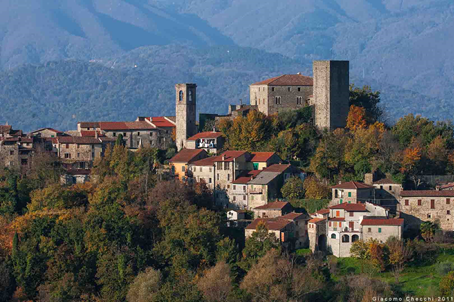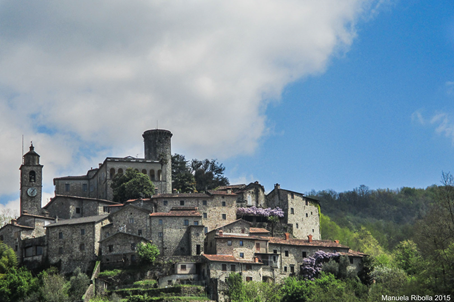Between Tuscany and Liguria. Lunigiana | Land of a Hundred Castles
Of all the less-traveled areas in Tuscany, or indeed in Italy, Lunigiana is one of the last genuinely Italian places to visit. A land of archaic traditions and ancient legacies. A land of booksellers, explorers, illustrious intellectuals, extraordinary women of great inventiveness, courage and perseverance. A land of farmers, millers, innkeepers and shepherds that to this day still believe in the value of their land. A border territory between the regions of Liguria, Tuscany and Emilia Romagna, an ancient political and strategic hub with a constellation of over one hundred Medieval and Renaissance castles; a fascinating territory rich in prehistoric treasures.
Departure from Milan to Lunigiana by bus is set for 7:30 am, arriving in Pontremoli at roughly 10:15. The itinerary begins with a visit to the Piagnaro Castle and to the Museum of Carved Standing Stones (“Stele”). Heading southwards, the village of Bagnone is the second stop on the route toward Castiglione del Terziere, a spectacular hilltop Renaissance site recently given a new lease of life thanks to the intellectual, Loris Jacopo Bononi.
If you ask exactly where Lungiana’s borders are located, you may have to endure a never-ending academic debate. You would be surprised at how many aspects of the local cultural heritage (borders, dialects and traditional recipes that change name from one valley to the next) elude precise definition. One thing, however, is universally accepted as a shared treasure throughout Lunigiana: the enigmatic faces of the Menhir Statues.

Museum of Standing Carved Stones, Pontremoli | © Trame di Lunigiana
The meaning of these votive statues carved thousands of years before Christ is still the subject of academic debate. In the last two centuries, people have unearthed a several dozens of them. After WWII, it seemed that anyone who dug deep enough or moved a bit of top soil in Lunigiana would find Menhir Statues, cryptic images of warriors and curvaceous women.
The most accredited explanation is that Menhir Statues represent ancestors or divinities, and serve as protectors of the area. The Menhir Statue Museum at Piagnaro Castle in Pontremoli has an impressive collection of Menhir, making it the perfect place to come face to face with their solemn, enigmatic, crescent- shaped profiles.

Castello del Piagnaro, Pontremoli | © Trame di Lunigiana
Built on a former Byzantine settlement, the castle was a Medieval fortress that dates back to before the year 1000. Its Golden Age was during the Renaissance 15th century when the castle was used as a residence for magistrates and officials of Florentine noble Signoria.
After years of neglect, as we are told by Loris Jacopo Bononi – who may well be considered the protective deity of its more recent history – the Castiglione del Terziere Castle was brought back to life following a massive restoration project. Every object, work of art, piece of furniture and document in the castle speaks of ‘how it would have been, if it had been’; in other words, the contents allow us to build an understanding of the culture that thrived here for centuries.

Castello di Castiglione del Terziere | Concorso Tramanda Lunigiana, G. Checchi
A similar undertaking lasting over thirty years led to the establishment of a library containing unimaginable treasures, including one of the first copies of Dante’s Divine Comedy printed by press and a historical archive of works and documents that testify to the endeavors and the genius of those who lived here.
Loris J. Bononi, a pharmacologist, doctor and poet – a true humanist intellectual – was the brains behind this rejuvenation. He dedicated himself fully to restoring the castle, converting it into a meta-museum for scholars, researchers and students who come to Castiglione del Terziere every year from all over the world.
Bagnone is one of the most striking fortified hilltop hamlets in Lunigiana. Perched on a hill in the Apennine National Park that straddles the Tuscany-Emilia border, it overlooks the gushing waterfall of the Bagnone river. Its most beautiful landmarks, which include the remains of a medieval tower, the elegant stone porches, the impossibly narrow alleys and the lively squares, make it a “must see” on any trip through Lunigiana.

Bagnone | Concorso Tramanda Lunigiana, M.Ribolla
The collection of oral and written history, stories of migration, traumas and adventures, photographs and diaries housed in the Memory Museum in Piazza Roma provide visitors with an open window onto the more recent – and relatively poorer – history of this territory, when thousands of people left in search of a better future elsewhere.